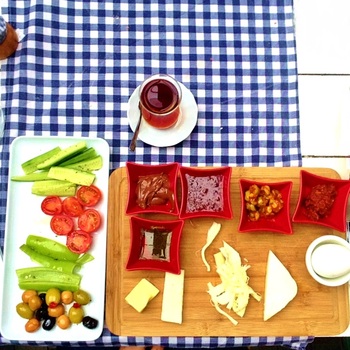-
The Turkish Gastronomy

The Turkish gastronomy is one of the most varied in the world. It is considered the third richest after the gastronomy of France and China.
In our European countries this kitchen does not enjoys great recognition. For us it is often limited to white sauce Kebab!
Turkey is a crossroads between Europe, Asia and the East. This unique geographical location combined with Turkish migration over the centuries from Central Asia to Europe has shaped the identity of its gastronomy.
The reciprocal influence between Turkey and its neighboring countries (Greece, Middle East, Balkan, Iran, Armenia ...) allow to find many common dishes in these cuisines such as dolmas, the boreks, and mantis (Turkish ravioli).
The great diversity of fauna and flora in Turkey also contributed to a great diversity of regional cuisines.
Turkish breakfast "kahvaltı"
(pronounce Kavalteu)In Turkey the breakfast is a full meal and very hearty and rather salty. The word originates from kahvaltı "Kahve Alti" meaning before coffee, kahvaltı is accompanied by a tea, coffee comes at the end after meals. We can divide the Turkish breakfast in 2 parts, the entries to be shared among the guests who typically consist:
A plate of tomatoes and cucumbers (Domates
 & Salatalik), a cheese plate (Peynir), the best known is the Beyaz Peynir (White Cheese). It is a cheese akin to the Feta it creamier and fluffy, honey with cream (Bal Kaymak), grilled sucuk (Turkish Chorizo, pork-free of course!), Olives (Zeytin) and jams (fencing).
& Salatalik), a cheese plate (Peynir), the best known is the Beyaz Peynir (White Cheese). It is a cheese akin to the Feta it creamier and fluffy, honey with cream (Bal Kaymak), grilled sucuk (Turkish Chorizo, pork-free of course!), Olives (Zeytin) and jams (fencing).Everything is spread on toasted fresh bread, simit or pogaca (these are small traditional Turkish breads).
Then comes the egg-based main dish served in an individual cassolette to keep them warm. There are 2 great dishes:
- The fried eggs, which can be eaten nature or accompanied by sucuk or Kavurma (lamb meat) and cheese.
- The Menemen, a scrambled eggs with tomatoes, onions, peppers with cheese option.
The Turkish breakfast is really something not to be missed to start the day off right!
-
Commentaires
